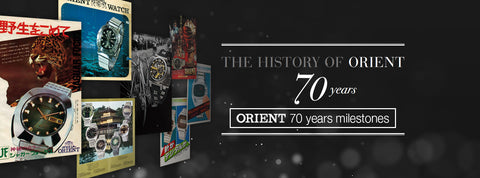
The making of Epson Seiko Orient
Tama Keiki Company, the predecessor to Orient Watch Company, was founded in 1950, but ORIENT’s beginnings date back to 1901 when the watchmaker Shogoro Yoshida opened the Yoshida Watch Shop in Ueno, Tokyo for the import and sale of watches. Yoshida began manufacturing watch cases from 1913, and founded Toyo Tokei Manufacturing which produced clocks in 1920. The company began manufacturing wristwatches from 1934, and completed the four-story Hino factory in 1936. Toyo Tokei Manufacturing had to be engaged in the mass production of aerial weaponry during the war. After the war, it was re-opened, but fell into financial difficulties and was dissolved.
In 1950, the employees of the Hino factory gathered together and began operations as Tama Keiki Company, which changed its name to Orient Watch Company in April 1951 and launched production of wristwatches, alarm clocks, and small bearings.
What is unique about Orient Watch is that just after the company was founded it invited Tamotsu Aoki to serve as an advisor. Aoki was a professor emeritus of the University of Tokyo. He served as the first chairman of the Horological Institute of Japan and instituted major changes to the Japanese watch industry as a theorist. Under his guidance, the reliability of ORIENT brand watches greatly improved. Orient Watch, which had recovered from the post-war confusion, released the center-second T-type movement in 1955, and the large-diameter N-type movement in 1958. It was the ROYAL ORIENT released that same year which was equipped with that movement. Having obtained a modern movement, Orient Watch began exporting its watches to Taiwan, the US, Canada, Iran, Brazil, and other countries.
Even today, ORIENT’s overseas business is larger than its business in Japan, and those foundations were laid back in the 1950s. The advance overseas forced ORIENT to boost its competitiveness. In 1961, ORIENT released the N-type self-winding movement which has a ratchet-type self-winding mechanism that brings to mind the Peraton-type self-winding watches of Swiss manufacturers. Ever since it obtained a level of competitiveness to challenge the Swiss manufacturers, ORIENT has placed a strong focus on uniqueness. Rather than lowering prices, the idea was to differentiate by design and mechanism and gain market share.
The forerunners were the Grand Prix 100 and the Flash, released in 1964. The Grand Prix 100 had luxury specifications with an L-type self-winding movement which replaced the N-type of its predecessors and increased the number of jewels to 100 jewels. The Flash was a watch that could illuminate the dial using an installed battery. While this idea itself was the same as the 1958 Luminous, the circumference of the dial was decorated with diamond-cut work, showing ORIENT’s devotion to design.
The 1965 WEEKLY AUTO ORIENT KING DIVER was also an experiment in design. The stylish design reminiscent of Swiss diver’s watches kept a line from the other diver’s watches in Japan at that time. Next, it was the 1967 Fineness which realized sophistication in both design and functions. The Fineness, which was created as the successor to the ORIENT Grand Prix, featured a Cal. 3900 movement which was the thinnest in the world at that time for a watch that displayed both day and date.
From the late 1960s, ORIENT further advanced its trend toward uniqueness. The Racer F3 with an egg-shaped case was released in 1968, and the colorful World Diver was added in 1969. Then the Jaguar Focus with its color-gradation-enhanced dial, which is said to be the most distinctively ORIENT, was released in 1970. Together with the cut crystal, this rein-forced the impression that ORIENT is associated with color. With changes in design, the existing L-type self-winding movement became too large and too thick. ORIENT had also been using Seiko movements, but released a Cal. 46 series self-winding movement manufactured in house in 1971. This is the mainline caliber still used by ORIENT today. ORIENT subsequently switched its pivot to manufacturing quartz watches, but also continued to release unique mechanical watch models including the Multi Year Calendar and the skeleton watch Mon Bijou. These may be considered the culmination of ORIENT’s pursuit of uniqueness in design and function. This direction continued to be followed by ORIENT’s subsequent mechanical watches. The M-Force released in 1997 was a distinctly ORIENT colorful sports watch with a Cal. 46 series movement, and the Mecha Trenics released in 2004 was an ambitious model with three movements normally used in women’s watches. It could only be created by ORIENT. Meanwhile, the ROYAL ORIENT released that same year was a highly refined watch reminiscent of original 1958 version and the 1967 Fineness. It was a masterpiece showing the richness of ORIENT’s design. ORIENT has consistently maintained this stance after its merger into Seiko Epson. The skeleton models from 2014 forward emphasize the appeal of mechanical watches by revealing the balance wheel, and were made even more attractive as watches by improving the interior and exterior workmanship. Rather than lowering prices, ORIENT struck the world with the allure of its functions and design. While the watch shapes have changed, that distinct individuality is still carried forward in today’s models.
